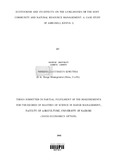| dc.description.abstract | This study was conducted in Amboseli ecosystem. The study aimed at characterising
ecotourism and assessing whether satisfaction was derived out of its experience; comparing
vegetation attributes and wildlife numbers in areas of different ecotourism intensities;
assessing ecotourism effects on the livelihoods of the host community and natural resource
management; and documenting the constraints facing its progress in the area. The study
invo lved surveys on visitors to the ecosystem and the local community through the
administration of questionnaires, vegetation sampling and animal counting that were field
inventory based, and analysis on stakeholders through discussions. Stratified sampling was
adopted for the survey on the community, wildlife counting and vegetation sampling.
Results indicated that most visitors came from the European countries (44.6%) and America
(36.6%), and were interested in natural features. Wildlife safaris (96.1 %) and photography
(89.1%) formed the major tourist activities, which may have resulted from lack of tourism
package diversification. Most visitors were satisfied with their trip experience (68.3%) and
expressed the will to make a repeat trip to the place (99%). Visitation declined over the last
decade (1990-2000) from over 200,000 to 87,000, which was attributed to deciining
environmental quality and competition from southern African nations among other factors
affecting both regional and national tourism. The ecotourism effect on the livelihoods of the
host community was more felt amongst the actively involved households through sale of
artefacts and employment. The incomes obtained helped reduce the reliance on livestock for
the involved households (60%) in comparison to pastoral (97.1%) and farming (65.7%)
households. Non-actively involved households mostly benefited through social projects. The
pastoral households expressed a negative attitude to ecotourism and wildlife. Inequitable
distribution of benefits (>70% in each group) was the most cited limitation to ecotourism.
This made ecotourism an unattractive land use to most residents. There was continued
reliance therefore on other land uses for survival. Costs from ecotourism unlike benefits
were widespread and were related to competition for resources, disease transmission to
livestock, loss of lives and injuries and the change of traditional practices and rules that
governed proper resource use.
Regarding the positive aspects, ecotourism promotion enhanced the adoption of mechanisms
for waste disposal, water treatment and pollution control amongst the lodge operators. It also
encouraged the maintenance and increase of wild fauna. Wildlife species were evenly
distributed in the area, showing no significant differences (P<0.05) in the three sites during
the wet season. Significant differences (P<0.05) only occurred along distance gradients in
the pastoral and nature-based tourism sites. The woody vegetation parameters under study
too showed significant differences (P<0.05) among sites and along distances within sites.
The participation of local people in ecotourism activities resulted in settlements, increased
livestock numbers and reduced mobility that caused overgrazing and deforestation. The
study therefore recommends that wildlife population dynamics be closely monitored to
maintain environmental quality, environmental impact assessment be carried out before
initiating community ecotourism projects, and diversification of tourism activities be
enhanced. A mechanism should also be developed to ensure equitable sharing of benefits
and promotion of environmental awareness amongst the local people. | en |

